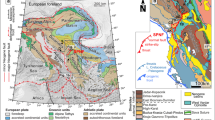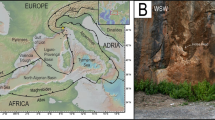Abstract
The Panvel flexure is a 150-km long tectonic structure, comprising prominently seaward-dipping Deccan flood basalts, on the western Indian rifted margin. Given the active tectonic faulting beneath the Panvel flexure zone inferred from microseismicity, better structural understanding of the region is needed. The geology of Elephanta Island in the Mumbai harbour, famous for the ca. mid-6th century A.D. Hindu rock-cut caves in Deccan basalt (a UNESCO World Heritage site) is poorly known. We describe a previously unreported but well-exposed fault zone on Elephanta Island, consisting of two large faults dipping steeply east–southeast and producing easterly downthrows. Well-developed slickensides and structural measurements indicate oblique slip on both faults. The Elephanta Island fault zone may be the northern extension of the Alibag–Uran fault zone previously described. This and two other known regional faults (Nhava–Sheva and Belpada faults) indicate a progressively eastward step-faulted structure of the Panvel flexure, with the important result that the individual movements were not simply downdip but also oblique-slip and locally even rotational (as at Uran). An interesting problem is the normal faulting, block tectonics and rifting of this region of the crust for which seismological data indicate a normal thickness (up to 41.3 km). A model of asymmetric rifting by simple shear may explain this observation and the consistently landward dips of the rifted margin faults.










Similar content being viewed by others
References
Allmendinger R W, Cardozo N C and Fisher D 2012 Structural geology algorithms: Vectors and tensors; Cambridge University Press, Cambridge, 289p.
Angelier J 1994 Fault slip analysis and paleostress reconstruction; In: Continental deformation (ed.) Hancock P L, Pergamon Press, Oxford, pp. 53–100.
Argles T W 2010 Recording structural information; In: Geological field techniques (ed.) Coe A L, Blackwell Publ., London, pp. 163–191.
Auden J B 1949 Dykes in western India – a discussion of their relationships with the Deccan Traps; Trans. Nat. Acad. Sci. India 3 123–157.
Bhattacharya G C and Yatheesh V 2015 Plate-tectonic evolution of the deep ocean basins adjoining the western continental margin of India – a proposed model for the early opening scenario; In: Petroleum geosciences: Indian contents (ed.) Mukherjee S, Springer, Switzerland, 61p.
Blekinsop T 2002 Deformation microstructures and mechanisms in minerals and rocks; Kluwer Academy Publ., Dordrecht, 105p.
Blanford W T 1867 On the traps and intertrappean beds of western and central India; Geol. Surv. India Memoir 6 137–162.
Cheeney R F 1983 Statistical methods in geology; G Allen and Unwin, London, 169p.
Chandrasekharam D 1985 Structure and evolution of the western continental margin of India deduced from seismic, geomagnetic and geochronological studies; Phys. Earth Planet. Inter. 41 186–198.
Collier J S, Sansom V, Ishizuka O, Taylor R N, Minshull T A and Whitmarsh R B 2008 Age of Seychelles–India break-up; Earth Planet. Sci. Lett. 272 264–277.
Cripps J A, Widdowson M, Spicer R A and Jolley D W 2005 Coastal ecosystem responses to late stage Deccan Trap volcanism: The post K–T boundary (Danian) palynofacies of Mumbai (Bombay), west India; Palaeogeogr. Palaeoclimatol. Palaeoecol. 216 303–332.
Dessai A G and Bertrand H 1995 The ‘Panvel Flexure’ along the western Indian continental margin: An extensional fault structure related to Deccan magmatism; Tectonophys. 241 165–178.
Doblas M 1998 Slickenside kinematic indicators; Tectonophys. 295 187–197.
Doblas M, Mahecha V, Hoyos M, Lopez-Ruiz J and Aparicio A 1995 Slickenside kinematic indicators in high and low-angle normal faults in the Alpine Betic Cordilleras southern Spain; In: Geological Society of America Penrose Conference on ‘Fine-grained Fault Rocks’, Leavenworth, WA.
Duraiswami R A, Bondre N R and Managave S 2008 Morphology of rubbly pahoehoe (simple) flows from the Deccan volcanic province: Implications for style of emplacement; J. Volcanol. Geotherm. Res. 177 822–836.
Faller A M and Soper N J 1979 Palaeomagnetic evidence for the origin of the coastal flexure and dyke swarm in central East Greenland; J. Geol. Soc. London 136 737–744.
Fleuty M J 1974 Slickensides and slickenlines; Geol. Mag. 112 319–322.
Fleuty M J 1987 Slikensides and slikenlines; In: The Encyclopedia of structural geology and plate tectonics (ed.) Seyfert C K, Van Nostrand Reinhold Co., New York, pp. 729–731.
Fossen H 2010 Structural geology; Cambridge University Press, Cambridge, 463p.
Ghodke S S 1978 Geology of the area around Panvel, Kolaba dist., Maharashtra; Unpubl. PhD thesis, University of Pune.
Gibbs A D 1984 Structural evolution of extensional basin margins; J. Geol. Soc. London 141 609–620.
Groshong R H Jr 2006 3-D Structural geology – a practical guide to quantitative surface and subsurface map interpretation; 2 nd edn, Springer (India), New Delhi, 400p.
Gudmundsson A and Marinoni L B 2002 Geometry, emplacement and arrest of dykes; Annal. Tecto. 13 71–92.
Hamblin W K 1965 Origins of ‘reverse drag’ on the downthrown side of normal faults; Geol. Soc. Am. Bull. 16 1154–1164.
Hobbs E B, Means W D and Williams P F 1976 An outline of structural geology; John Wiley and Sons, New York, 571p.
Hooper P, Widdowson M and Kelley S 2010 Tectonic setting and timing of the final Deccan flood basalt eruptions; Geology 38 839–842.
Jackson J and McKenzie D 1983 The geometrical evolution of normal fault systems; J. Struct. Geol. 5 471–482.
Klausen M D 2009 The Lebombo monocline and associated feeder dyke swarm: Diagnostic of a successful and highly volcanic rifted margin?; Tectonophys. 468 42–62.
Kundu B and Matam A 2000 Identification of probable faults in the vicinity of Harnai–Ratnagiri region of the Konkan coast, Maharashtra, India; Curr. Sci. 78 1556–1560.
Marrett R A and Allmendinger R W 1990 Kinematic analysis of fault-slip data; J. Struct. Geol. 12 973–986.
Mohan G and Ravi Kumar M 2004 Seismological constraints on the structure and composition of western Deccan volcanic province from converted phases; Geophys. Res. Lett. 31 L02601.
Mohan G, Surve G and Tiwari P K 2007 Seismic evidences of faulting beneath the Panvel flexure; Curr. Sci. 93 991–996.
Misra A A, Bhattacharya G, Mukherjee S and Bose N 2014 Near N–S paleo-extension in the western Deccan region, India: Does it link strike-slip tectonics with India–Seychelles rifting?; Int. J. Earth Sci. 103 1645–1680.
Myers J S 1980 Structure of the coastal dyke swarm and associated plutonic intrusions of East Greenland; Earth Planet. Sci. Lett. 46 407–418.
Nielsen T F D and Brooks C K 1981 The East Greenland rifted continental margin: An examination of the coastal flexure; J. Geol. Soc. London 138 559–568.
Pande K, Sheth H C and Bhutani R 2001 40Ar– 39Ar age of the St. Mary’s Islands volcanics, southern India: Record of India–Madagascar breakup on the Indian subcontinent; Earth Planet. Sci. Lett. 193 39–46.
Petit J P and Laville E 1987 Morphology and structures of hydroplastic slickensides in sandstones;In: Deformation of sediments and sedimentary rocks (eds) Jones M E and Preston R M F, Geol. Soc. London Spec. Publ. 29 107–121.
Ragan D M 2009 Structural geology: An introduction to geometrical techniques; Cambridge University Press, Cambridge, 602p.
Samant H 1997 A geomorphic analysis of the Mumbai–Mumbra region and its applications using a geographic information system; Unpubl. Ph.D. thesis, IIT Bombay, 233p.
Sethna S F 1981 Geology around Bombay – some intriguing problems; In: Deccan volcanism (eds) Subbarao K V and Sukheswala R N, Geol. Soc. India Memoir 3 87–92.
Sethna S F 1999 Geology of Mumbai and surrounding areas and its position in the Deccan volcanic stratigraphy, India; J. Geol. Soc. India 53 359–365.
Sheth H C 1998 A reappraisal of the coastal Panvel flexure, Deccan Traps, as a listric-fault-controlled reverse drag structure; Tectonophys. 294 143–149.
Sheth H C and Pande K 2014 Geological and 40Ar/ 39Ar age constraints on late-stage Deccan rhyolitic volcanism, inter-volcanic sedimentation and the Panvel flexure from the Dongri area, Mumbai; In: Flood basalts of Asia (eds) Sheth H C and Vanderkluysen L, J. Asian Earth Sci. 84 167–175.
Sheth H C, Ray J S, Senthil Kumar P, Duraiswami R A, Chatterjee R N and Gurav T 2011 Recycling of flow-top breccia crusts into molten interiors of flood basalt lava flows: Field and geochemical evidence from the Deccan Traps; In: Topics in igneous petrology (eds) Ray J, Sen G and Ghosh B, Springer, pp. 161–180.
Sheth H C, Zellmer G F, Demonterova E I, Ivanov A V, Kumar R and Patel R K 2014 The Deccan tholeiite lavas and dykes of Ghatkopar–Powai area, Mumbai, Panvel flexure zone: Geochemistry, stratigraphic status and tectonic significance; In: Flood basalts of Asia (eds) Sheth H C and Vanderkluysen L,J. Asian Earth Sci. 84 69–82.
Sheth H, Pal I, Patel V, Samant H and D’Souza J 2017 Breccia-cored columnar rosettes in a rubbly pahoehoe lava flow, Elephanta Island, Deccan Traps and a model for their origin; Geosci. Front. (in press).
Srinivasan V 2002 Post-Deccan Trap faulting in Raigad and Thane districts of Maharashtra; J. Geol. Soc. India 59 23–31.
Storey M, Mahoney J J, Saunders A D, Duncan R A, Kelley S P and Coffin M F 1995 Timing of hotspot-related volcanism and the breakup of Madagascar and India; Science 267 852–855.
Sukheswala R N and Poldervaart A 1958 Deccan basalts of the Bombay area, India; Geol. Soc. Am. Bull. 69 1475–1494.
Wager L R and Deer W A 1938 A dyke swarm and coastal flexure in East Greenland; Geol. Mag. 79 49–56.
Wernicke B 1985 Uniform-sense normal simple shear of the continental lithosphere; Can. J. Earth Sci. 22 108–125.
Wernicke B and Burchfiel B C 1982 Modes of extensional tectonics; J. Struct. Geol. 4 105–115.
Widdowson M and Mitchell C 1999 Large scale stratigraphical, structural and geomorphological constraints for earthquakes in the southern Deccan Traps: The case of denudationally driven seismicity; In: Deccan volcanic province (ed) Subbarao K V, Geol. Soc. India Memoir 43(1) 425–452.
Wynne A B 1886 On the geology of the island of Bombay; Geol. Soc. India Memoir 2 174–227.
Yamaji A 2007 An introduction to tectonophysics: Theoretical aspects of structural geology; Terrapub, Tokyo, 386p.
Zellmer G F, Sheth H C, Iizuka Y and Lai Y-J 2012 Remobilization of granitoid rocks through mafic recharge: Evidence from basalt-trachyte mingling and hybridization in the Manori–Gorai area, Mumbai, Deccan Traps; Bull. Volcanol. 74 47–66.
Acknowledgements
We thank two anonymous referees for detailed and critical reviews which helped us to significantly improve the content and presentation, and N V Chalapathi Rao for his editorial handling.
Author information
Authors and Affiliations
Corresponding author
Additional information
Corresponding editor: N V Chalapathi Rao
Rights and permissions
About this article
Cite this article
Samant, H., Pundalik, A., D’souza, J. et al. Geology of the Elephanta Island fault zone, western Indian rifted margin, and its significance for understanding the Panvel flexure. J Earth Syst Sci 126, 9 (2017). https://doi.org/10.1007/s12040-016-0793-8
Received:
Revised:
Accepted:
Published:
DOI: https://doi.org/10.1007/s12040-016-0793-8




